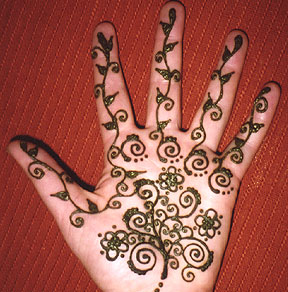
However, even though the cultural meaning is lost with the Western appropriation, it is still intact when worn by South Asians. Now this is a troubling fact that is also expressed in the video that we saw in class. There is no distinction between American born South Asians and foreign born South Asians; as long as they wear the symbols they will be looked at as foreigners and that it suits them as an ethnic symbol. On the contrary, when worn by White Americans, they are reduced to elements of exotic ethnic decorations. Other than that, there is no preservation of cultural significances. The only time I've seen it preserved is in an independent film titled "Chutney Popcorn".

In the movie, the main character is a young South Asian lesbian woman who is in a relationship with a young White American woman. The main character is also a henna artist and she does a lot of designs for her partner and the design actually symbolizes their relationship. The appreciation of her partner is one that truly take into the cultural heritage of the practice into consideration. She did not wear the designs simply as decorations that enhance her beauty but as a symbols of her love for the South Asian artist that is her partner. Nonetheless, that is a movie example. I might not know but have yet to come across a real life scenario.
The sad thing about the appropriation is that those who are bought into the idea of consumerism will now have to pay great amount of money for a henna design while ethnically, it is made at a very "low price" or even without cost. Consumer culture does know how to rake profit, just like what happened to the Hip Hop movement.
An trailer of the movie from youtube.com
Entry #4
by Nghia Trinh
Sources:
Maira, Sunaia. "Henna and Hip Hop: The Politics of Cultural Production and the Work of Cultural Studies." 2000.
Chutney Popcorn. Direct by Nisha Ganatra. 1999.
1st image from alwaysfabulousevents.blogspot.
2nd image from biwriters.livejournal.
Trailer from youtube
No comments:
Post a Comment